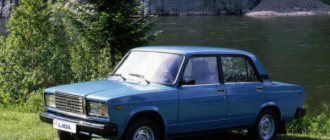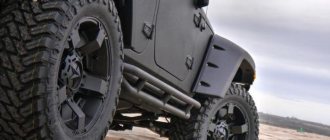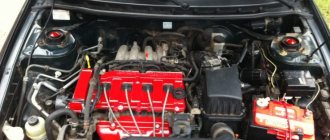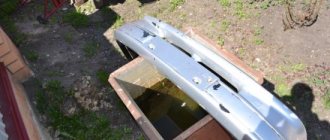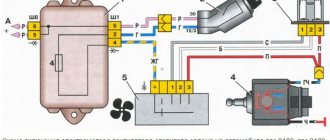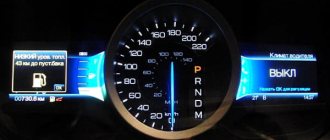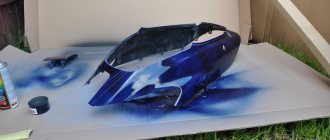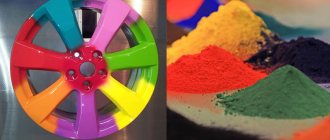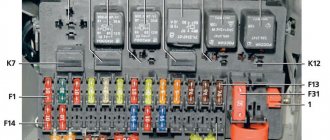No matter how diligently you take care of your car, it is impossible to avoid minor scratches and damage.
Most often, the top layer of paint is damaged when parking, when the doors were unsuccessfully opened or there were stones on the road.
In any case, the damage is not significant, it is not always possible to notice it immediately, but over time it can turn into a serious threat and become a problem.
In this case, you just need to contact a car service. There you will already have to shell out a more serious amount of money.
Therefore, while the problem is insignificant, they prefer to eliminate it at the root, not go anywhere, but simply paint it on their own using spray paint.
The method is very economical and does not require special knowledge.
I saw it on TV and it became interesting
In some car television programs you can see how the presenters themselves paint individual elements, and sometimes the entire car, using primer and paint in spray cans. Every time I saw such a repair, I had a desire to test with my own experience what could come of it.
The 21-year-old Lancia Delta HPE was completely repainted about three years ago. During this time, defects appeared on some body elements, in particular, “bugs” on the trunk lid, and the paintwork on one of the moldings peeled off.
I have some experience in the field of auto body repair; I could easily remember my student years and eliminate existing shortcomings using professional equipment. But in this case, I would never have received an answer to a question that has long interested me. So I took a risk.
Spray cans of car paint are sold both in regular large supermarkets and in construction stores, and in some of them you need to pay less than 10 rubles for 500 ml of paint. “Suspiciously cheap,” I thought and went to buy paint at a specialized store that sells everything needed for car body repairs.
Advantages and disadvantages
The use of balloon varnish for various substrates has the following number of practical advantages:
- Quick application - no need to use additional equipment and tools.
- Can be used under any circumstances - in the workshop, on the road, in the parking lot.
- Economic benefit – low cost, lack of consumables.
Universal use of car polish in cans Source ytimg.com
- Minimum time to get it into working condition - the varnish in car spray cans dries within just a few minutes.
- High aesthetic indicators - no smudges or streaks, uniform distribution.
- Versatility in application – both in materials and surface geometry.
- Convenient for application in hard-to-reach areas of the product.
- Quick learning of application technique.
- A variety of compositions according to aesthetic qualities - gloss, matte, shine, with shades and colorless.
There are no downsides to aerosol varnishes as such. Disadvantages can only be associated with a violation of the application technique, the requirements of the instructions, as well as a malfunction of the can itself. For example, sometimes the spray device becomes unusable or the pressure inside drops.
Coating metal utensils with transparent varnish Source stroy-podskazka.ru
First troubles, but thanks to the spoiler
We apply the paint in several layers so as to prevent the formation of sagging and smudges, as well as “lack of dust.” Already on the second layer it becomes clear that in some places the paint begins to react with old materials. Fortunately, this happened in those places that are covered by the spoiler, and in one place on the molding. Therefore, despite the nuances that have appeared, we continue to paint.
After applying four layers, at first it seems that the result is not so bad, the experiment was a success. But if the reaction appeared in places where the spoiler could not hide it, one could talk about the failure of the “operation” to save money on painting.
It didn’t turn out that bad, so we ventilate the garage and leave the car until tomorrow until the paint dries.
When the paint finally dried, the result, to put it mildly, was no longer pleasing. The shine completely disappeared, many nuances became noticeable that were not visible immediately after coloring.
It was impossible to leave the trunk like this - it looked simply terrible. I had two options: completely redo the whole job and paint the trunk with primer, paint and varnish for professional use, or try to remedy the situation by sanding and polishing the trunk.
Preparing for painting
Before you start painting your car, you need to purchase the following materials:
- rubber spatulas;
- sandpaper of different grain sizes;
- two-component primer and putty (acrylic for deep scratches and chips);
- spray paint;
- solvent;
- polishing emulsion or autovarnish.
Preparing the car for painting
Experienced mechanics advise painting a car in the summer so that the paint dries quickly and the room is well ventilated. Since the paint itself is highly toxic.
The room should be free of flies, mosquitoes and other insects that could stick to the painted body.
Steps to prepare for painting after the necessary materials have been purchased:
- Park the car in a garage or any other room.
- Dilute the detergent in warm water and wash the car.
- Let it dry for half an hour at a temperature of 18 to 22 degrees.
- Degrease the surfaces that will be puttied and then painted.
- Dampen a rag with solvent and wipe the scratches.
- Then wipe them with a dry towel.
- Apply tape to those surfaces that should not be affected by the paintwork.
- Prime scratches or severely chipped areas on the body.
- Degrease again with solvent and wipe dry.
- Putty the surface with a special solution using an aerosol can. Spray carefully from the edge of the part. Cover vertically, not horizontally.
- Wait until dry, sand with sandpaper. The sandpaper will be easier to use if you put it on a sanding machine or a small block.
After all the scratches have been primed and sanded, you can begin spray painting the car.
DIY car spray painting
Let's save the situation
In my understanding, sanding and polishing the surface after painting goes beyond the scope of “budget” DIY repairs. To do this, you need to have a polishing machine, wheels and polish, but the vast majority of ordinary car enthusiasts have nothing of the kind. Therefore, in fact, the mission to save money on painting can be considered a failure - of course, if you do not want to put up with the disgusting appearance of your car.
Nevertheless, four layers of paint gave me the opportunity to try to correct the situation.
P2000 sandpaper with water and two types of polish using wheels of varying hardness helped in this matter.
Almost all the imperfections have disappeared, and a more or less normal shine has appeared. Painted, albeit with nuances, the molding began to look much more presentable.
In general, after all the procedures, the rear of the car looks a little better, because the “bugs” on the trunk lid did not decorate the car at all. The final quality of painting is no worse than what some garages can offer. But don’t forget that there are places under the spoiler where the paint reacted.
In addition, you can notice the difference in shades.
Varieties
Depending on the dilution technology used, there are three categories of balloon varnishes:
- H.S. Varnish with a rigid structure. Includes predominantly a non-volatile component and only 10-15% solvent. Therefore, almost all of the applied substance remains on the surface. Characterized by a slight degree of fluidity. Apply in 2 layers.
- MS. It is characterized by greater fluidity due to up to 50% solvents included in its composition. The application technology includes 3 layers. In this case, a pause of 15 minutes is required between procedures.
- 1 TO. Characterized by increased fluidity. The solvent share is more than half. Allows you to reduce painting time.
Varnishes are also classified according to their chemical composition. There are three main types of paints and varnishes of this type:
- Polyurethane.
- Acrylic.
- Nitrocellulose.
Let's look at their features in more detail.
On the packaging, manufacturers indicate what kind of base the varnish has. Source cloudinary.com
Our verdict
You can paint a car with a spray can, but achieving a really good result is almost impossible. And with a complex color, it will be even more difficult to hit it. It was possible to give the painted surface a more presentable appearance only after additional sanding and polishing.
The materials, excluding the purchase of polish and wheels, took about $20, as well as three evenings. I definitely wouldn’t risk painting the hood this way, for example. In three words - so-so pleasure. You can only spray paint thresholds made from construction foam and putty to pass inspection.
Body parts in the Automotive Business ad database. Almost 210 thousand offers!
Selection criteria – transparent, colored, odorless, glossy, matte
When choosing a varnish for a specific application, the consumer has to solve a series of practical questions - is it possible to find a car varnish that does not produce a strong odor in cans, which is the best of those available on the market - transparent or colored, glossy or matte.
The right choice of varnish is a guarantee of coating quality Source gidpokraske.ru
These problems can be solved based on personal preferences and aesthetic requirements for the surface in each specific case. However, there are also a number of standard recommendations:
- Gloss is preferable for a black/dark object when you need to highlight contrast, transition, or image. The downside is that any flaw becomes clearly visible on the surface.
- The matte surface looks more natural. In addition, they emphasize the style of the product and facilitate the cleaning procedure.
- Transparent varnish does not change the color of the surface or its natural texture. For example, it is used for wood, car wheels and optics.
Colored compounds are used when it is necessary to enhance an existing shade. Moreover, due to the specifics of the structure being created, the applied layer increases the strength of the surface.
- Odorless aerosols allow you to paint indoors when ventilation is impossible or the harm of fumes during drying is obvious. Mostly water-based acrylic varnishes have these characteristics.
Coating a car with spray varnish Source kraski-net.ru
Advice! When choosing a varnish, two parameters are of utmost importance for subsequent use - absorbency and gloss. Water-based products are absorbed shallowly. A highly shiny surface makes the object visually dark.
Spray cans with two-component paint and varnish products
Now there are cans of two-component paint. The container with the hardener is inserted into the valve at the bottom of the can and thus the hardener gets inside and the whole mixture is mixed with a ball while shaking. If the hardener gets in, the shelf life of such paint is significantly reduced.
p, blockquote 42,0,0,0,0 —>
Such cans give excellent results when painting, comparable to painting with a spray gun. Cured paint is more wear-resistant than one-component paint.
Briefly about the main thing
Car varnish in a can significantly speeds up and simplifies the surface varnishing procedure. Thanks to this, it finds wide application - in body repair, painting furniture and interiors, in construction, as well as in the creation of souvenirs, toys, works of art and electrical equipment. Among its obvious advantages are:
- Quick to use.
- Availability in any circumstances.
- Economical.
- Quick return to working condition.
- Versatility to any materials and surface geometry.
- Aesthetics.
- Ease of use in hard-to-reach places.
- Diversity.
No special skills are required to use the can. However, some disadvantages may arise in the operation of the device - breakdown of the atomizer, loss of pressure. Depending on the degree of dilution, varnishes are divided into hard HS, soft MS and high fluidity 1K. In terms of composition, they are alkyd, polyurethane, nitrocellulose, and also mixed. When choosing, you must take into account its aesthetic characteristics, absorbency and shine, store and use it in accordance with the recommended rules.
Applying paint
As mentioned above, after the primer has dried, you need to apply paint to the car. There are several rules by which this should be done.
- Firstly, you need to wear a mask and goggles when working with paint, this is necessary so as not to accidentally get into your eyes and inhale toxic fumes.
- The paint should be applied at a distance of approximately 25-30 centimeters. This ensures neat painting without smudges.
- Spray paint should be applied to the car body in at least two layers.
Between layers you need to wait for each layer to dry; you need to apply paint at intervals of 15-25 minutes.
- In addition, you need to paint a new area with each layer, thanks to which the paint goes on smoothly with the old paint, and it is not noticeable that the car was painted with a spray can.
